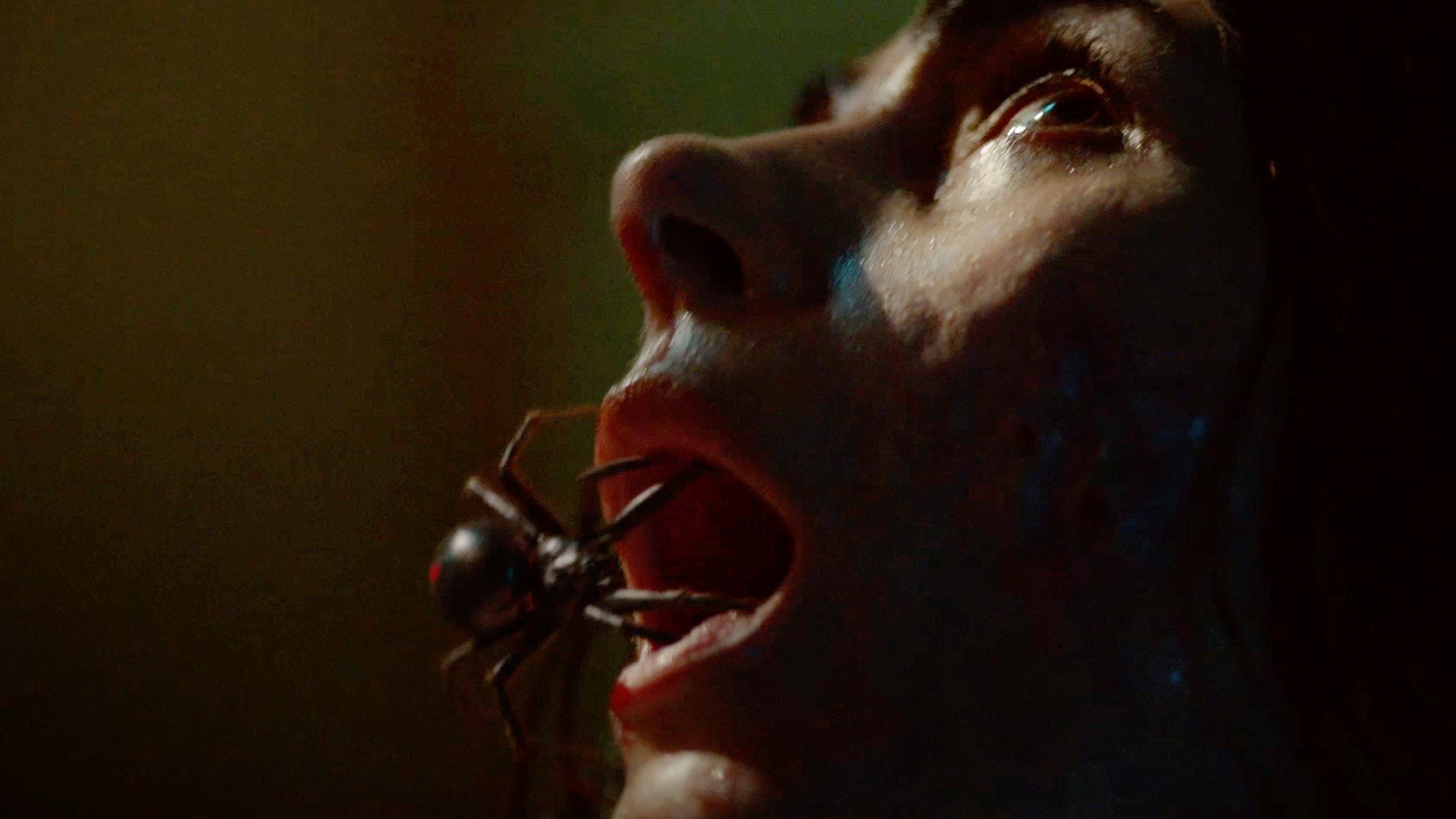Reviews
‘Sting’ Review – Throwback Creature Feature Entertains With an Impressive Practical Monster

Writer/Director Kiah Roache-Turner wears his influences on his sleeves in the throwback creature feature Sting. A mysterious object from outer space crashes into a New York apartment amidst a raging blizzard, where the mysterious spider inside it is discovered by a girl named Charlotte (Alyla Browne, Furiosa). Charlotte dubs her new pet Sting, unaware that it’s not from Earth and comes with an insatiable appetite for human flesh. As the spider’s reign of terror increases, so does Roache-Turner’s commitment to capturing the mayhem through stunning practical creature effects, which makes this film worth the price of admission.
It’s not just the spider’s pet name, derived from The Hobbit, or the effects by the 5-time Academy Award® Winner Wētā Workshop, led by Creative Director Richard Taylor, that calls the work of Peter Jackson to mind here. It’s also the film’s sense of humor, from the opening sequence that introduces a comedic exterminator (The Blackening’s Jermaine Fowler) to the building’s oft-quirky tenants. The exterminator’s initial antics, combined with the bickering between older tenants Noni Hazlehurst (The End) and Robyn Nevin (Relic, “Wolf Like Me “), feel in line with Jackson’s early splatter era. It’s the type of silliness that injects a sense of fun while we wait for the eight-legged menace to feed and grow to uncontrollable levels.

Working against the zaniness of the building’s residents is the central family drama centered around young Charlotte. Charlotte is fearless and intelligent, but beneath her tough exterior is a vulnerable young girl struggling with feelings of abandonment. Bonding with stepdad Ethan (Ryan Corr, Wolf Creek 2) has derailed with the arrival of Charlotte’s newborn sibling, leaving her feeling further displaced despite Mom (Penelope Mitchell, Hellboy) trying to help. Sting latches onto the thorny relationship between Ethan and Charlotte, framing it as a new stepfather trying desperately and failing to connect with a child in dire need of a father figure, using it as the emotional backbone.
Browne quickly establishes herself as an actor that can turn on the final girl toughness or childlike vulnerability in an instant. Sting rests largely on her capable shoulders. Less effective is Corr, who is serviceable enough as the adult assisting Browne in the action-heavy finale but less so when it comes to Ethan’s emotional arc. Ethan often reacts in extremes, lashing out in frustration in ways that feel excessive. Smaller domestic woes get blown out of proportion. It can be jarring to the point of distraction, leaving you eager for the spider horror to kick into overdrive.

To that end, Sting delivers on its creature. Sting feels like a fully realized, albeit inhuman, character almost from the outset. Roache-Turner frames his spider with intelligence; there’s an amusing deviousness as small Sting strategically maneuvers about the building and sets about conquering it. The filmmaker also knows how to let the effects work shine, first by showing just enough of the spider in larger form to make its off-screen hunting moments intense. Then, through a full-on monster assault that borrows a page or two from Alien. In keeping with the throwback creature feature vibe, Roache-Turner also ensures that the deaths are inventive and mean-spirited. One extended death scene, in particular, keeps layering on the creature feature cruelty in inventive ways.
Sting is at its strongest when it focuses on the horror. The steady build-up to its showstopper finale offers tense spider horror moments as Sting slinks around air ducts or darkened corners and delivers more than one gnarly death. But the film is also rife with family drama that doesn’t quite mesh with the horror or overall tone. Thanks to Browne’s bold performance and an emphasis on practical creature effects, Sting works as an entertaining creature feature with a memorable new movie monster.
Sting is in theaters on April 12, 2024.


Reviews
‘Clue: A New Comedy’ Stage Play Is a Slapstick Slasher That Lovingly Adapts Hasbro’s Board Game

The national tour of ‘Clue: A New Comedy’ remixes the classic murder mystery with farcical physical comedy and impassioned old-fashioned sensibilities.
“It’s all part of the game.”
There’s a strong relationship between mischievous murder mysteries and the horror genre. Murder mysteries inherently hinge upon death – it’s baked into the name – so it’s not surprising that horror has embraced this secretive subgenre and really emphasized the murder in murder mysteries. Murder mysteries have been popular in pop culture for nearly a century. However, there’s been a recent renaissance on this front with playful films like Knives Out, A Haunting in Venice, Bodies Bodies Bodies, the Scream franchise, and the prominence of the true-crime genre and armchair detectives. That being said, an underrated and evergreen source of murder mystery hijinks that’s entertained audiences for 75 years is Hasbro and Parker Brothers’ Clue.
Clue has experienced many permutations over the years, including Jonathan Lynn’s 1985 cult classic film and several stage adaptations. In a new dawn where board game and toy IP are at an all-time high, a new stage adaptation of Clue has been put together by Sandy Rustin, with additional material by Hunter Foster and Eric Price, and directed by Casey Hushion. Hushion’s Clue: A New Comedy, which is in the middle of a national tour, effortlessly harkens back to vaudevillian silliness and broad laughs, while it simultaneously explores darker genre impulses and intrigue. It’s the perfect way to nostalgically celebrate the ’80s movie, but also remind audiences why Hasbro’s upcoming cinematic remake is long overdue.
Hushion’s Clue is an adaptation of Lynn’s ‘85 film, but it still brings many original ideas and revisions to the table so that this doesn’t just feel like a stripped down version of the movie. Clue: A New Comedy finds immense pleasure in how it translates the game’s rules so that it functions as a faithful adaptation of the game and the feature film, while it also becomes a fun, fresh entity that’s a living hybrid of both. In Clue: A New Comedy, blackmail functions as the story’s central mystery, just as it does in the board game and cinematic adaptation. Each color-coded houseguest has terrible secrets that they don’t want getting out, which becomes the impetus for the growing body count.
Clue is a comedic character study and this stage play presents well-defined individuals who are easy to identify and connect with, despite their one-dimensional nature. Mr. Green (John Shartzer) is the cast’s real standout, but there’s not a single weak link among Clue’s eight central players. Clue’s best moments are the ones when the whole cast gets to bounce off of each other and revel in the group’s chaotic energy. The play’s ‘50s McCarthyism setting also adds an extra layer of mistrust, paranoia, and subterfuge to the equation that still feels timely in its own way. Farcical, broad wordplay – especially from John Treacy Egan’s Colonel Mustard – are a delight and reminiscent of an old-fashioned radio play when it comes to Clue’s jokes, timing, and dialogue.
Beyond Clue’s script lies some exceptional physical comedy, particularly from Shartzer’s Mr. Green. There are broad group reactions that play out in unison for mass comic effect, as well as lighting cues that brilliantly accentuate punchlines and become a solid running gag throughout the 90-minute show. There are playful movement exercises that are expertly choreographed and verge on interpretative dance. Clue adopts a real Scooby-Doo energy to the production, especially when it comes to its scene transitions. Clue even indulges in a “multiple door chase sequence” that taps into the right energy for this degree of slapstick. To this point, there’s an absolutely brilliant slow motion sequence that’s a highlight of the show and adeptly incorporated.
Clue’s characters are its secret weapon, but stellar production elements help elevate the stage play to something truly special. There’s really powerful set design by Lee Savage that evokes a creepy, cozy Haunted Mansion aesthetic that’s the right atmosphere for this murder mystery tale. Clever design decisions result in rotating walls and rooms that economically get the most out of the stage’s environment. Clumsy execution of these elements would quickly sink Clue and ruin its crescendoing quality. They’re seamlessly handled, as are Ryan O’Gara’s evocative lighting design and Michael Holland’s jauntily creepy musical cues. All these elements work together to make sure that Clue is as visually entertaining as it is well-acted and written.
Clue: A New Comedy goes all-in on its laughs. That being said, the play’s death scenes are actually creepy and immaculately orchestrated with all the finesse of peak genre cinema. There are genuine slasher vibes present that pulse through the show’s pervasive slapstick silliness. It’s a testament to the sheer artistry of craft in Clue that both of these extremes work as well as they do. Clue also shrewdly embraces the infamous multiple ending angle that helped give Lynn’s feature film a smart extra meta layer to its storytelling. It’s fun, different, and takes advantage of the medium of theater to great effect. It’s also the satisfying culmination of a story that gets progressively manic, unhinged, and verges on collapsing in on itself by the end – but in the best way possible. Clue pushes boundaries with tone and control like an expert puppet master.
Clue: A New Comedy hits all the right notes and succeeds as a breezy piece of theater that celebrates whodunit hijinks, broad buffoonery, and wicked wit. It’s Agatha Christie meets Frasier. Clue is a show that definitely prioritizes comedy over horror and suspense, but there’s enough style in this production to properly sell the production’s more evil impulses. It’s unlikely that anyone will be genuinely frightened, yet the play will still keep audiences on the edge of their seats and eagerly anticipate who’s responsible for Boddy Mansion’s copious corpses. Clue: A New Comedy is the best way to experience the Hasbro and Parker Brothers classic before its next cinematic adaptation proves that murder and mayhem aren’t just a game anymore.
Go to Broadway.org to see if ‘Clue: A New Comedy’ will be coming to your area.


Photo by Evan Zimmerman for MurphyMade













You must be logged in to post a comment.